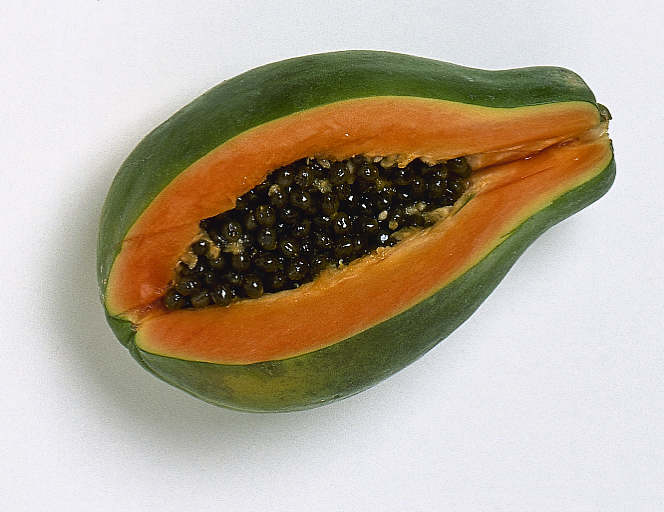Flower EncyclopediaENTER THE WORLD OF FLOWERS |
Other News
Carica papaya
Category: Exotic fruits and vegetables
05 Apr : 14:15
To view pictures click on them




 Papaya (Carica papaya) is a tropical tree, growing in hot, humid areas of Central and South America, South Africa and Southeast Asia. This is known under different names - often referred to as "tree melons (in China and Sri Lanka) or" fruta bomba "in Cuba, Lechosa in the Dominican Republic, but most used Caribbean has had his name" papaya ", as Europeans first discovered this fruit that is in the Caribbean.
Papaya (Carica papaya) is a tropical tree, growing in hot, humid areas of Central and South America, South Africa and Southeast Asia. This is known under different names - often referred to as "tree melons (in China and Sri Lanka) or" fruta bomba "in Cuba, Lechosa in the Dominican Republic, but most used Caribbean has had his name" papaya ", as Europeans first discovered this fruit that is in the Caribbean.Pope reaches a height of between 5 and 10 m and fruits are round or elongated shape with the leaf and bark pinkish-orange inside, a taste similar to a mixture of melon and peach. Inside, containing many black seeds that are used dried and ground as a condiment. The fruit is highly valued because of their high content of vitamins (A, B, C, D and E), minerals (calcium, potassium, phosphorus) and micronutrients (iron, zinc, manganese, copper, vanadium, magnesium). Therefore be used with curative intent for the disposal of toxins from the body, improve digestion, in liver diseases, viral hepatitis and others. Consumed as fruit mature (in desserts, cakes, fruit salads) and more immature as garnish.
For the first time Europeans discovered the fruit of the Indies, and so began to call him by his name Caribbean. This exotic "melon, which grows on tree melons, many vitamins contain - almost the whole list from A to F. In addition, it was discovered the enzyme papain, which effectively downloaded overweight. When you buy a papaya, choose fruit with smooth yellow rather than green bark. The meat of the papaya has a beautiful pinkish-orange color and the taste is somewhere between peach and melon. The bark is white, the seeds are clean - again as a melon. In addition to the unique culinary taste papaya has one more nemalovazhno dignity - universality. Can be used as a fruit and vegetable, but it is always medicine. Ripe papaya fruit is consumed as dessert, poured gently with lemon juice or fruit salad. Unripe papaya is a vegetable and used for salads and garnishes (such as fish, cooked on grill). A dried and crushed seeds of papaya are a wonderful spice that is added to sauces and vinaigrette.
Some varieties:
Solo - its color varies from green to a shade zhaltenikav half yellow, half green. The flesh is pale orange.
Jamaican - Less than solo, but with a sweeter taste. The meat is pink.
Fruit:
The fruit is round or elongated shape, like a melon, with a weight of 0, 5 to 9 kilograms. The core of the papaya is juicy and smooth, with sweet flavor, similar to the melon. Inside it has a round black seeds taste of pepper, which is usually removed, but made for a meal.
Cultivation:
To have no problem with papaya grown at home, you need regular pruning to its large stalks. Fruits are formed only when the plant gets 30 to 60 centimeters high. Pope gives fruit after 6 months to mature for 6 to 8 months. The plant is seen in warm (at least 20 degrees) and bright. Requires moderate watering and regular fertilizing.
The pope does not contain fat and cholesterol, have low sodium content. It is a good source of fiber and folic acid, rich in vitamin A and C, and also vitamins B-complex. The enzyme papain stimulates digestion.
Directions for use:
Papaya can be served peeled, sliced and fields with lemon juice.
Half of the fruit may be full of fruit salad or salad with chicken, tuna, shrimp.
Ground seeds of the fruit to enjoy dressing for salads.
Pope may be added to the marinade or the boiling of meat to be used as a vegetable.
| fruta bomba papaya fruit time europeans enzyme papain liver diseases |
Comments are turned off for this item0
| fruta bomba papaya fruit time europeans enzyme papain liver diseases |























































